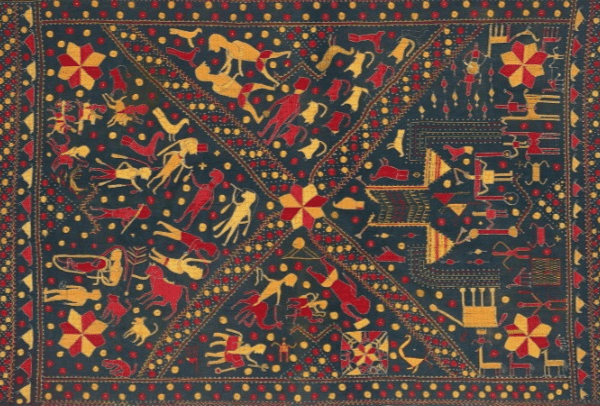The production of Banarasi Sarees began in Varanasi primarily due to the relocation by the weavers of Gujarat to Benares in the seventeenth century due to the catastrophic impact of the famine in 1603. It eventually led to the emergence of multiple weaving centers across the entire city. This led to the establishment of a tradition wherein a group of weavers collectively work under the supervision of a skilled artisan within each center.
With the increasing span of time, the fondness for the Banarasi Saree got enhanced. They gradually became a must have for all the Saree lovers. The admiration for this attire grew exponentially as a bridal trousseau and as an occasional wear due to its timeless elegance and the indomitable appeal. As the time progressed, these sarees carved out a space for themselves in majority of the wardrobes which strengthened its recognition across the globe.
If you examine the factual basis behind the aesthetics of this highly celebrated attire, you would come across the diverse types of weaving techniques which give a distinct identity to each saree by bestowing it with one or the other special feature.
The core focus area of this account will be the major weaving techniques which transform the appearance of the Banarasi Sarees in such a way that they become all the more aesthetically pleasing. By the end of this account, you all would become well versed with the distinguishing features, distinct designs and the fabrics in which these weaves are available.
In case of Banarasi Sarees, the weaving process is quite significant due to the following reasons-
•They augment the visual aesthetics of the Sarees with the exquisite embellishments.
•The variety of beautiful motifs created with the diverse range of weaves serves as a testimony of the creative expertise of the craftsmen.
•The touch and feel of the Sarees is also modified with the way they are woven.
•Each weave used in the Banarasi Sarees recount a narrative about the cultural legacy of the source region.
•The immense variation in the weaving techniques render a number of alluring patterns over the surface of the Sarees.
Weaving a Saree is itself a form of a craft. It thoroughly exemplifies the cultural tradition of a particular region. The weaves of a Saree determine its quality, attractiveness and its ability to depict cultural values.
The weaving process of a Banarasi Saree involves a great amount of precision and rigor. It includes a series of steps-
▪︎Preparing the Blueprint of the Design- The design is initially drafted over a Graph paper and it is subsequently passed on to the Punch Cards. They are quite helpful to facilitate the procedure.
▪︎Installing the Loom– The Loom is positioned along with the threads. Each thread is lined up cautiously in order to ensure greater accuracy in the whole exercise.
▪︎The Execution of Weaving- The weavers act in accordance with the Punch Cards weave the threads onto the fabric. It also includes the interlacing of the warp and weft threads.This task is accomplished with utmost prudence by the weavers.
The notable weaving methods used in creating the highly famed Sarees from Benares are as follows-
Table of Contents
Cut Work – A Widely Known Method
Cut work is the most popular weaving technique of Banarasi Sarees. If you have ever owned a piece of banarasi, you must be familiar with it.
All the patterns are woven together over the Saree and the extra thread is cut on the back of the outfit under this process.
Katan Silk, Tussar Silk, Georgette Silk, Cotton and Organza Silk are the principal fabrics used in the Banarasi Sarees with Cutwork weaving.
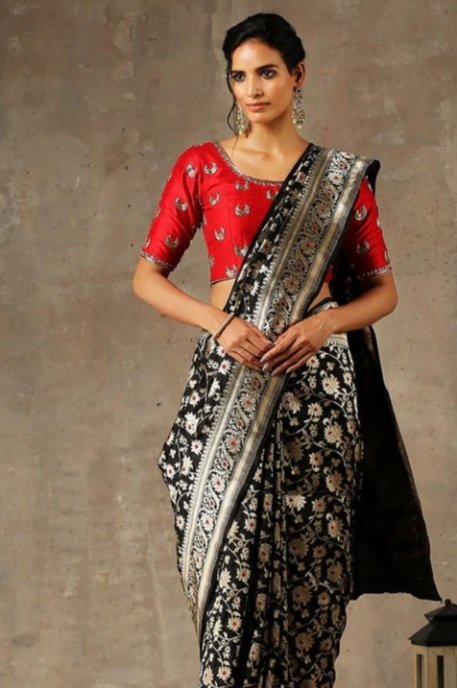
The most popular patterns of a Cut work weaved Banarasi Sarees are-
•Floral Designs which are inspired from Jasmine and Marigold flower.
•Geometric Motifs.
•Paisley Patterns acquired from the Mughal empire’s artwork.
•Motifs based on natural elements like creepers and leaves.
These Sarees are available in a variety of colours which consists of Rich Red with Gold, Royal Blue with Silver, Royal Purple and Emerald Green.
It is preferred by the artisans due to its minimum time consumption and its application on all kinds of silk yarns along with its availability in majority of motifs.
The interweaving of patterns is a fundamental characteristic of this weaving method.
Each saree weaved using the cutwork illustrates a perfect balance between traditional pattern and contemporary style.
Kadhwa- A Vigorous Process
Kadhwa is the most arduous technique across all the weaving methods due to the elaborate nature of the patterns and plenty of time consumption involved in their creation.
Each design is woven individually within this method which cessates the need of cutting work while weaving.
The diverse range of motifs used in this method include-
•Bud like patterns, popularly known as Butis.
•Dense Designs which consist of a network of flowers, leaves and vines.
•Sizeable Floral Elements
referred to as Dooria.
•Diamond and Square Shaped Patterns which are developed using supplementary coloured silk threads are called Katra.
This weave is available in diverse range of colours like Pure Green, Pure Red, Pure Black, Pure Yellow, Mustard, Turquoise, Light Pink, Deep Maroon, Orange, Magenta, Beige, Gold and White among others.
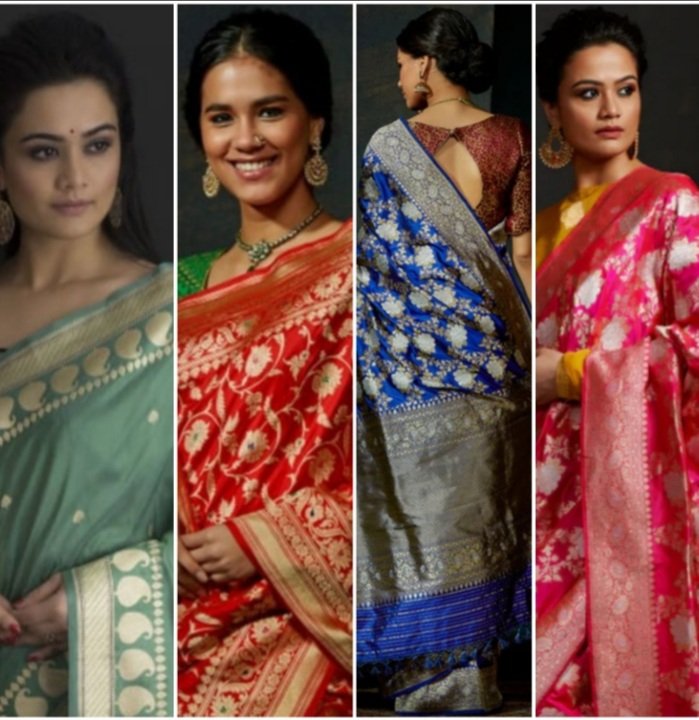
You can catch the glimpse of a Kadhwa Weave Banarasi Saree mostly in natural yarns including cotton , linen and silk fabric. The major types of silk includes Katan Silk, Muga Silk, Eri Silk, Kora Silk, Tussar Silk and Dupion Silk.
The attribute which makes it distinctive from all other weaving techniques is the variation it offers in terms of colour pattern, proportion and appearance of the motifs on the Saree.
Banarasi Sarees are also woven using an interesting technique called Meenakari.
It can be produced by employing both the Kadhwa and Cutwork weaving methods. The most interesting fact regarding Meenakari is its exquisite zari work and the colorful nature of the silk threads used in it.
The patterns used in this specific weave include floral, paisley and zig zag border designs. The creative aptitude of the artisans is visible within these resplendent Handloom Sarees.
Kadhiyal- The Source behind the Magnificent Borders
If you are still curious to know about the reason behind the heterogeneity of the border of the Banarasi Sarees, you will come across an appropriate answer in an interesting weaving method which is none other than the Kadhiyal technique.
It is used for creating a variance within the color shade of the border and the remaining part of the whole outfit.
The process of dyeing warp in variety of colours is undertaken along with altering the weft shuttle while weaving of the Saree continues.
Three Shuttles are employed in this method for weaving the border of the upper and lower portion of the garment along with the body of the Saree. A shuttle is basically a small device that is used to move the weft thread across the loom. In a Banarasi Saree, warp and weft are the two essential segments. In case you are wondering about their meaning, warp means the vertical threads which extend upon the loom before the process of weaving begins and weft refers to the horizontal threads which are woven in a back and forth manner while passing through the warp threads.
At last, all the segments are attached together with an interlocking procedure which is referred to as Kadhiyal in the local dialect of Varanasi.
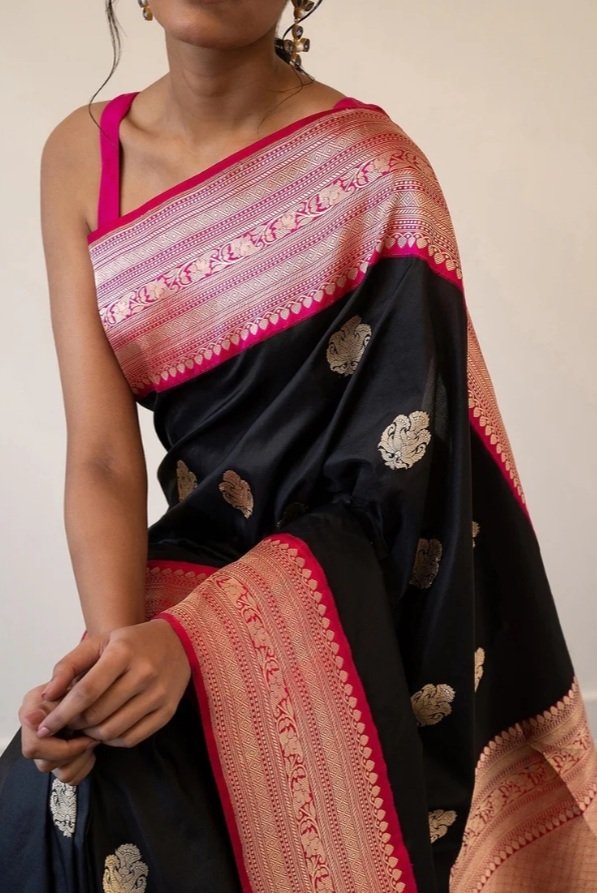
The silk threads having exceptional quality are utilized during the process of Kadhiyal weaving. It can stands out through its elaborate designs amongst other weaving techniques.
Rangkat- A Phenomenal Weaving Technique
If you are willing to have a glimpse of an authentic banarasi saree, choose the one which is woven with a Rangkat weave- a conventional weaving method.
It developed out of the Kadhwa process of weaving. You can easily single out a Rangkat Saree through the precise variations within the color scheme of the base fabric of the garment.
It makes use of diverse types of crossovers in the yarn and modifications in the weft structure in order to create a contrasting color pallete in the outfit.
A Rangkat weave Banarasi Saree exhibits a myriad of patterns which consist of the following-
▪︎Floral Designs of Roses, Lotuses, Marigolds and Jasmine.
▪︎Geometrical Motifs.
▪︎Continous Patterns collectively referred to as Jaal.
▪︎Paisley and Elaborate Designs drawn from Mughal and Persian era.
▪︎Sona-Rupa Zari Work wherein Sona Rupa translates to Gold and Silver Zari threads respectively).
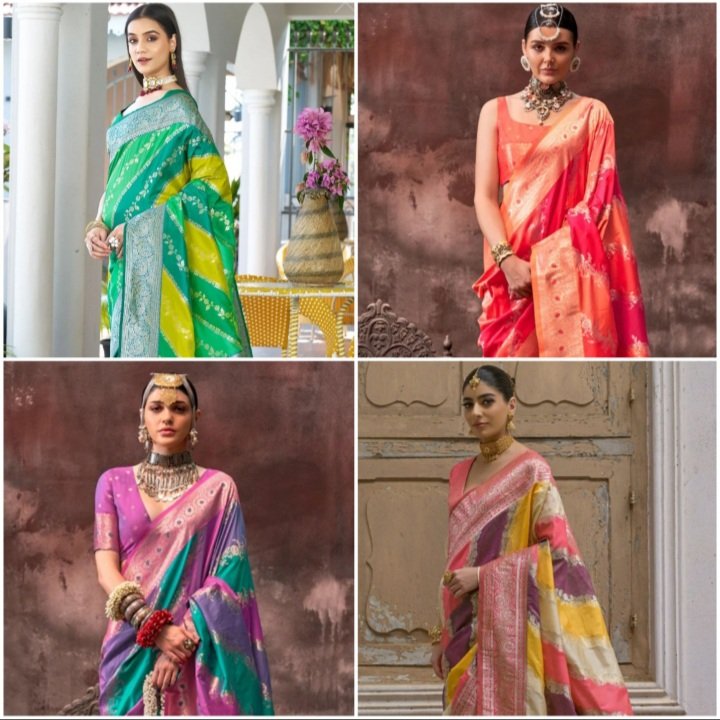
A Rangkat Saree has a distinct texture and drape due to its base Fabric- silk, cotton and chiffon.
This technique has garnered a lot of admiration due to its detailed patterns, magnificient zari work and distinguishable color gradation across the Saree. It is valued across the country due its colour transition which is attained through weaving rather than printing or dyeing. The handloom weaving process transforms each Saree into an extraordinary piece.
Jangla- A Weave Offering a Fascinating Glimpse of Nature
If you’re ever curious to know about one of the oldest method used for weaving Banrasi Sarees, you will find a definite answer while exploring about an interesting technique i.e Jangla which is used for weaving Banarasi Sarees since many centuries.
The motifs within the whole design are closely related with each other in this method. This technique intensifies the profoundness of the fabric and it accords a sense of an engraved design to the onlookers with the prudent application of the glittering zari threads of golden and silver color.
The motifs of the Jangla weaved Banarasi Saree are derived from Natural Vegetation and Wildlife including Animals, Birds and Trees.
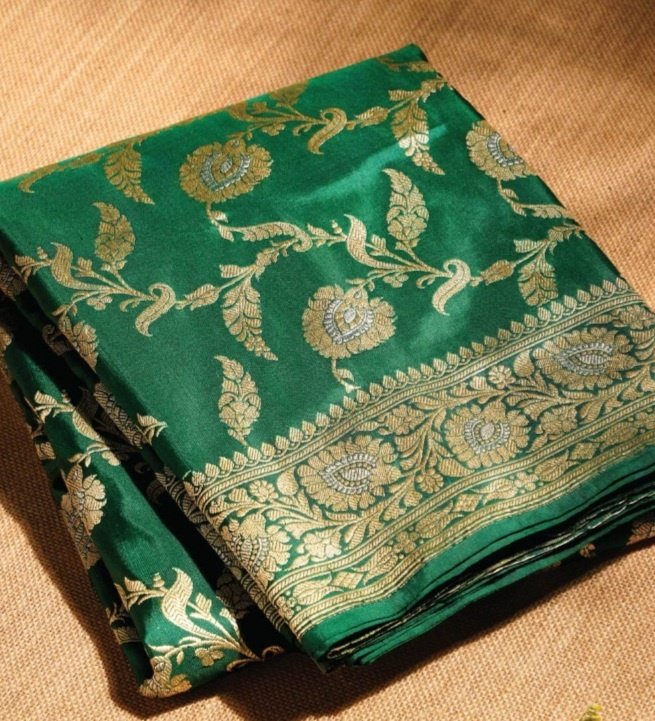
Katan Silk, Organza, Georgette and Shattir are the most prominent fabrics of the Banarasi Sarees crafted with the Jangla weave.
The color shades which are in vogue in a Jangla weaved Banarasi Sarees are- Beige, Yellow, Purple, Blue, Green, Peach, Off-White, Red, Pink and Maroon.
This process of weaving is majorly utilized for the creation of detailed designs upon the aanchal (portion of a saree that is draped upon the shoulder) and the border area of the Banarasi Sarees.
Every Saree created with this process has a regal finish which has earned them a place in majority of wardrobes.
Ektara- A Finest Technique
The weave that has massive popularity in Varanasi due to its exceptional features is none other than the Ektara weave.
This technique is executed on a Gethua Loom by applying the Paanch Kaadhi technique in a conventionally used pit loom. “Gethua” means the multiple warp heddle shafts on the loom. The shafts are basically utilized for modifying the warp threads individually in order to produce intricate motifs. Paanch Kadhi Method includes the usage of five treadles on the loom which are employed for altering the warp threads to develop the preferred pattern.
All the Banarasi Sarees with Ektara weave have a vibrant colour pallete.
These Sarees are made up of assorted types of fabric including Cotton, Silk and Linen.
The key attribute of Ektara weaving is the manual weaving of silk threads along with the shimmering zari threads that are involved in its manufacturing process. It produces a mesh kind of structure in the fabric which gives a sense of an elevated pattern to the people. The geometric elements form a major part of its overall design composition along with flowers and leaves.
This weave has always been treasured by the aristrocrat class due to the exquisite illustration of the innovative skills of the artisans engaged in the preparation of these Sarees.
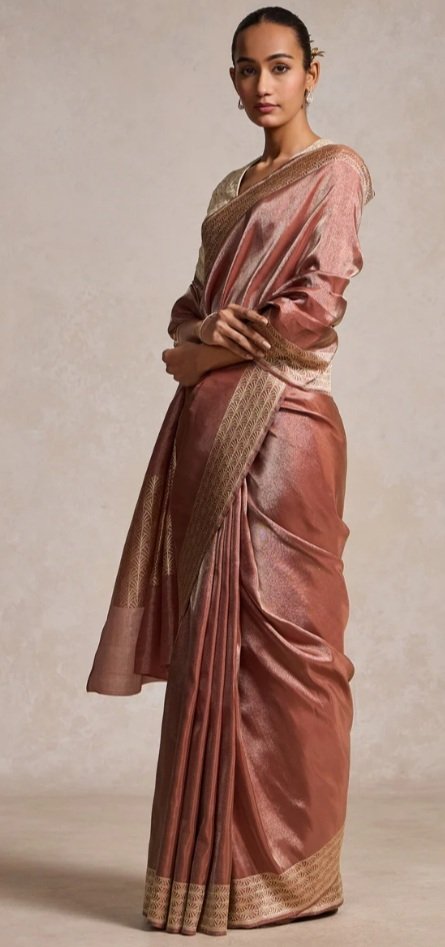
Brocade- A Weaving process synonymous with Floral Designs
Whenever you would have heard about the Banarasi Sarees, you must have come across the term Brocade. You would be amazed to discover it as one of the frequently used technique of weaving these exquisite outfits.
Brocade makes a thoughtful use of the supplementary weft threads to establish an upraised impact upon the resultant design which enriches the aesthetic appearance of the Sarees.
It facilitates the process of crafting complicated motifs through the usage of the jacquard loom and its attachments including Jala, Paiga and Naka. The zari threads used within this weaving method enhances the attractiveness of the whole attire.
In brocade weave, there is a special significance of flowers as they are a prominent part of the whole design arrangement. The main flowers from which the beautiful patterns are derived are Roses, Lotuses, Marigolds and Jasmine. Other notable motifs consist of creepers, paisley and betel leaf.
The Brocade Banarasi Sarees are available in a diverse range of colours like Pastel Shades, Metallic Variants, Earthy Hues and Brighter Colour Patterns.
The majority of Brocade Banarasi Sarees are available in Katan Silk, Raw Silk, Tissue Fabric, Muga Silk, Chanderi, Dupion Silk, Tussar Silk and Kora Organza.
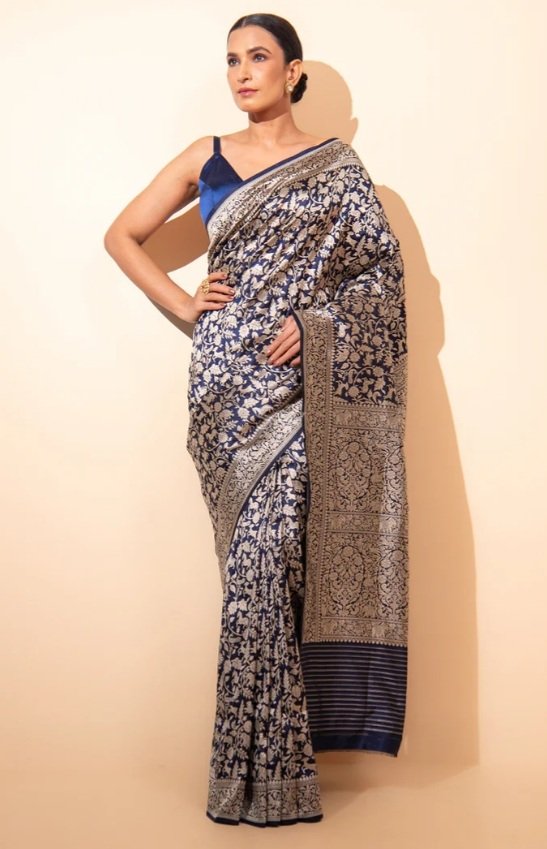
Tanchoi-An Intricate Weaving Method
The Tanchoi weaving technique of Banarasi Sarees is carried out using either a single or double warp and multiple types of weft which belong to a same color tone. As a result, a self design pattern is developed on the fabric which does not leave any excess threads at the back of the outfit.This technique is well known due to its complex and elaborate motifs.
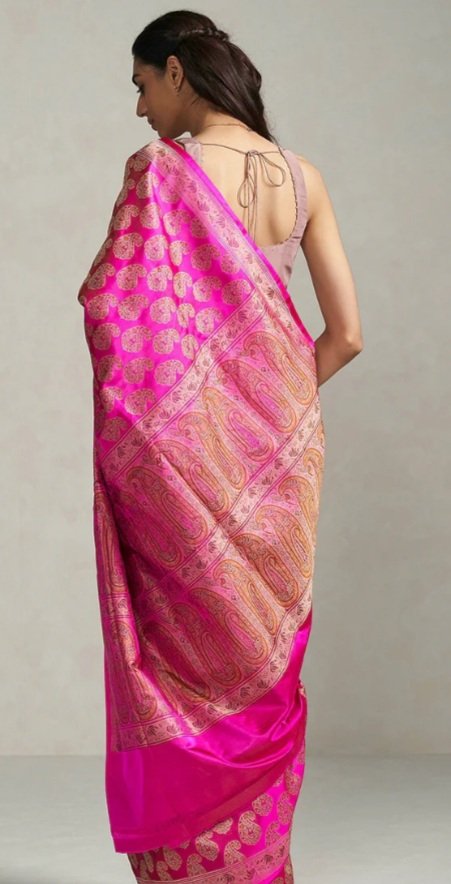
The garments produced through Tanchoi weaving showcase the following patterns-
▪︎Paisley
▪︎Floral
▪︎Geometric Motifs
▪︎Peacock
▪︎Parrot
There is an interesting narrative behind the name of Tanchoi weaving method. This skill was acquired by three weavers of Surat from a Chinese teacher called Chhoi in 1856. They named their craft as Tanchoi by embracing the name of their teacher- ‘Chhoi’ along with citing the Gujarati word ‘Tran’ which means three as ‘Tan’. This produced a new word called Tanchoi by combining the two terms- ‘Chhoi’ and ‘Tran’.
The speciality of this weaving process lies in the vivid colour pallete of the Sarees.
Zari Vasketi- A Perfect Process for an Attractive Adornment
Zari Vasketi Method is a classical technique of weaving Banarasi Sarees.Since it is primarily used for the embellishment of Silk Fabric, it exhibits an umpteen amount of luminance. This method symbolizes luxury and is praised for its everlasting elegance.
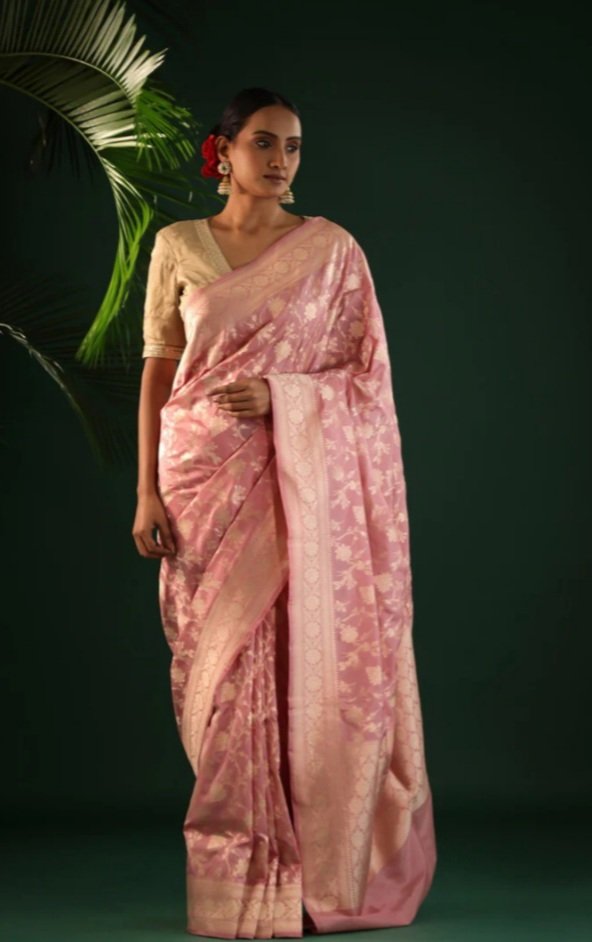
The diligent usage of zari threads as the supplemental weft over the whole body of the fabric reduces the likelihood of float at the back of the material. The supplemental weft basically refers to an additional horizontal thread over the base fabric of the outfit. The distinguishing feature of this method is the application of zari(metallic thread) over the entire surface of the outfit rather than a specific segment of the garment.
The defining features of this renowned weaving method are-
•A Magnificent Handiwork
•The Radiant Ensembles
•Immensely Attractive Patterns
Hope you all have been acquainted with the critical role played by the weaves in making Banarasi Sarees an eminent garment across the world. All of you must have become apprised of the significance of the handcrafted process of weaving behind establishing the everlasting eminence of the Banarasi Sarees.



